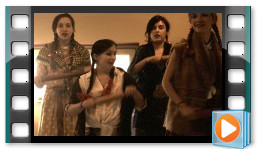"Cztery dyny"
Cztery dyny performed by XI LO Choir
Wielkopolska
Information about the region
This is a province created in 1999 in central-western Poland, situated in Wielkopolska Lake District, in the central part of Wielkopolsko-Kujawska Lowland and in the basin of Warta river. The province is divided into 35 administrative districts and 226 communes. Poznań with the population of 570 thousand is the biggest city among 109 towns in the region. The biggest towns are: Kalisz, Konin, Piła, Ostrów Wielkopolski, Gniezno and Leszno. All of them are significant centres of commerce and social life in their areas.
The capital and at the same time economic, scientific and cultural centre of Wielkopolska is Poznań. This historic city dates back at least a thousand years back and is closely related to the beginnings of the Polish state system. Kalisz is the second biggest urban centre in Wielkopolska with important administrative, economic, social and cultural functions.
Wielkopolska Province is one of the biggest regions in Poland. It occupies the area of 29825 km2, which is the second in Poland, and has the population of 3346 thousand, placing it on the third place in our country.
Fig.1 Wielkopolska Province on the map of Poland
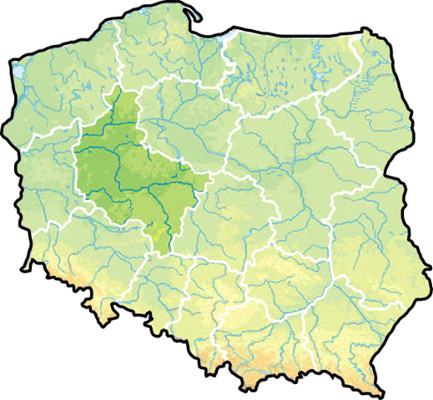
Traditions and rituals
Traditional St. Martin croissants.
St. Martin croissants are a traditional Wielkopolska region dish – according to the custom baked mainly on 11 November – St. Martin day. Nevertheless, they are available both in Poznań and the rest of Poland all year long. Their status was changed, however, in 2008 by an EU order, when the name “Rogal Świętomarciński” (St. Martin croissant) was written in the European system of the protection of geographical indications and designation of origin. Due to the order, this particular name cannot be used to products baked outside Wielkopolska.
As the legend says, the tradition dates back to pagan times, when during autumn feast oxen were given in sacrifice to gods. Dough shaped in form of horns served as the substitute. As it usually happens in such cases, Christianity adopted the custom, linking it this time with the person of saint Martin. The shape of the dough symbolized a horseshoe, lost by the saint’s horse.
Wielkopolska Dances
Contrary to impulsive and spontaneous dances of other regions, these ones from Wielkopolska are dignified and solemn. They have various forms, though, according to the microregion. "Wiwaty" (cheers), “przodki” (fronts) and “chodzone” (walked) are typical Wielkopolska region dances, nowadays to be seen performed only by folk groups during different types of ceremonies and folk festivals.
Fig. 2 Folk Song and Dance Ensemble from Poznań
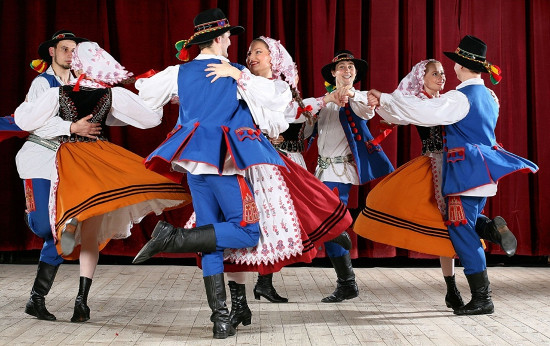
Traditional Wielkopolska national costumes
The more ethnic groups there are, the more kinds of national costumes we have. There remained several national costumes, for example the one of Biskupianie regional group, the costume from Szamotuły region, the one from Dąbrówka Wielkopolska region or the costume from Ziemia Lubuska region. Colouring is the most characteristic to all of them. These are the shades of red and navy blue with black elements. The fabric from which the costume was made was also important together with the quality and precision of cut and sewing. Ornaments were of minor importance.
Fig. 3 National costume from Szamotuły region.
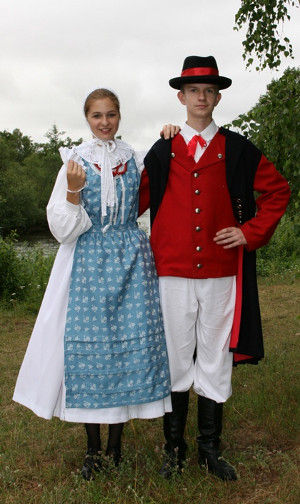
Music
- “Wiwat” (cheers) dance is very common
- It is danced and sung above all during the ritual of wedding and the wedding reception as well as during all kinds of rural dances
- Measure is mainly common 2/4, but sometimes ¾
- Tempo is lively, quite fast, in the south part of the region it is more lively and in the north – slower
- The scale is closely connected with the scale of instruments which play the dominant role in particular regions of Wielkopolska
- Wielkopolska is the land of bagpipes (common from the XVI century)
- In the regions where bagpipes prevail the melody of “wiwat” (cheers) goes on the finger holes of the bagpipe
- The scale of the bagpipes is not mitigated, singers’ intonation goes with the scale
- Melodies – wide ambitus (sometimes eleventh), fast tempo, no wailing, they always start on the strong parts of the time, and the accents are scattered
- Rubato is the characteristic manner
- Walking with a maypole also exists in this region
- The ceremony of rural wedding is the biggest collection of folklore
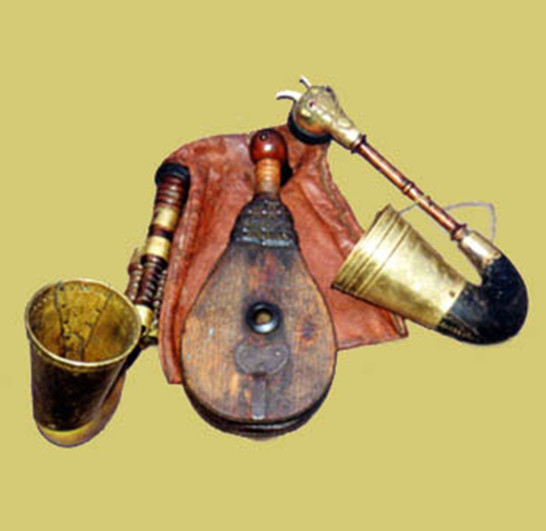
Famous people from the region
Anna Jantar – a Polish singer and artist.
Wojciech Fibak – a Polish tennis player, Masters’ finalist and four times quarter-finalist of grand slam singles tournaments.
Krystyna Zofia Feldman – a Polish actress, known mainly from expressive episodic roles.
Anita Włodarczyk – a Polish athlete specializing in hammer throw.
